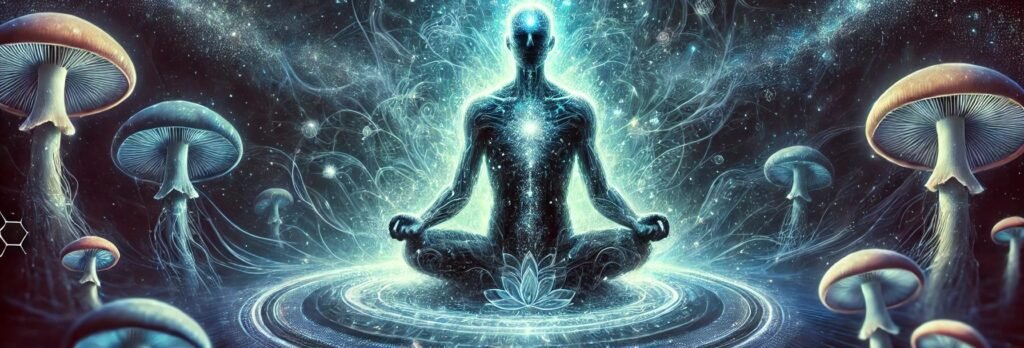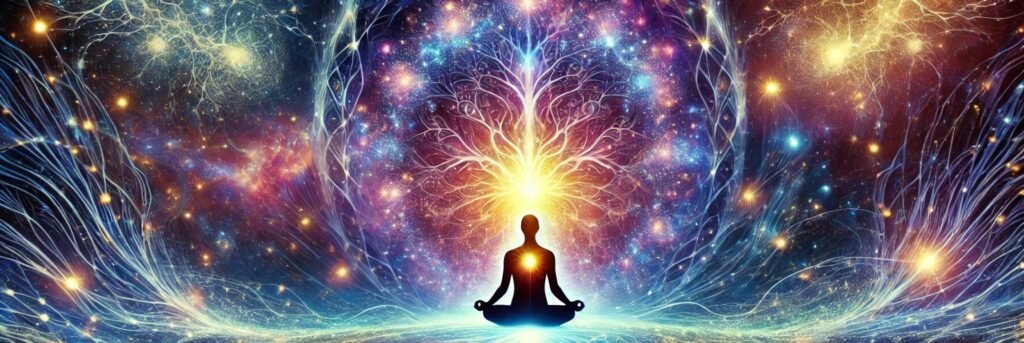Searching for Reality in No-Space
For centuries, seekers, mystics, and philosophers have grappled with the questions “What am I?” and “Who am I?”—questions that challenge us to confront the very nature of reality and our place within it. Recent breakthroughs in quantum physics and cosmology offer astonishing insights into these questions, revealing a universe that defies our conventional understanding of space, time, and individuality.
Podcast
What if the answers to these age-old questions don’t lie within the boundaries of our identity but within the intricate, interconnected structure of reality itself? The latest findings in quantum geometry, cosmic voids, and entanglement hint at a profound vision of existence that challenges our sense of self, opening up a view of reality where “who we are” and “what we are” may be far more complex—and interconnected—than we imagine.
You are not a drop in the ocean. You are the entire ocean in a drop.
Rumi

Beyond Space and Time
In physics, we’ve long considered space and time the bedrock of existence, the backdrop against which reality unfolds. However, recent discoveries in quantum geometry suggest that these familiar dimensions are not fundamental but emergent. Space and time appear “constructed” from a deeper, more abstract layer of reality outside our ordinary perception.
This quantum geometry represents a timeless, spaceless structure built from relationships between quantum states rather than objects in space. This shift in perspective suggests that the true nature of reality might not be defined by “things” at all but by an intricate network of connections existing beyond any concept of “here” or “now.” This means that the “you” that you experience may not be an isolated entity in space but rather an expression of this vast, interconnected geometry.
So, if reality is woven from relationships, what does that say about who we are? Are we defined by the edges of our body and mind, or are we part of this infinite, relationship-based structure that permeates all things?
In the intricate fabric of the cosmos, we are not entities but expressions—woven from the threads of everything that exists and exists beyond.

The Richness of “Nothingness”
Cosmic voids—vast, seemingly empty regions of the universe—offer another profound insight into the nature of reality. Once considered barren gaps between galaxies, these voids are now understood to be dynamic spaces filled with subtle gravitational fields and traces of dark matter. Though they appear empty voids, they are interwoven with the cosmic web, exerting influence and connecting distant structures across the universe.
In a way, these voids reflect the paradox of self-inquiry. Just as we assume ourselves to be solid, separate beings, we often imagine the “void” within us—moments of silence or inner emptiness—devoid of meaning. But cosmic voids show us that emptiness is not nothingness; it’s an active, rich field of influence, subtly shaping the structure around it. Perhaps, when we look into the quiet spaces within ourselves, we aren’t finding absence but encountering a deeper connectivity.
Could our sense of self be like a cosmic void—an isolated phenomenon that is, in truth, deeply integrated with everything around it? If so, perhaps the “I” that we search for lies not in identity or personality but in a field of awareness that, like cosmic voids, subtly connects us to the whole.
What is essential is invisible to the eye.
Antoine de Saint-Exupéry

Entanglement
One of the most intriguing discoveries in quantum mechanics is the phenomenon of entanglement—the mysterious connection between particles that allows them to influence one another, regardless of their distance, instantaneously. Once particles become entangled, they continue to “know” each other’s state even across vast distances, hinting that the universe is inherently interconnected at levels far beyond our usual perceptions.
Entanglement challenges the idea of separateness for those seeking to understand “who” or “what” they are. If particles can be fundamentally connected across space, then individuality—our sense of being distinct entities—might be just an illusion generated by our senses. The implications are profound: just as particles may be fundamentally interconnected, we might also be woven into a cosmic web, inextricably linked to all others.
So, who are we, if not separate beings? Could it be that our true nature is more like a node in a network, an inseparable part of an endless field of relationships? Entanglement hints that there is no such thing as true separation; at our core, we may be an interconnected field of awareness, bound to all things in ways that defy the limits of space and time.
The universe is a single atom: the convergence of science and spirituality. By coming closer and closer to reality, we see that it is only composed of relationships.
Dalai Lama

A Bridge Between the Finite and the Infinite?
Another cutting-edge area of physics involves the quest to detect gravitons, hypothetical particles that would unify gravity with quantum mechanics. Currently, gravity operates on a cosmic scale, while quantum forces rule the microscopic world. By finding a bridge between these forces, physicists hope to unlock a unified understanding of reality that encompasses both the infinitely small and the infinitely large.
The search for gravitons is particularly intriguing for those pondering the nature of self and reality. If gravity operates at the quantum level, it might suggest that a force of unity draws together every particle, every atom, and every point of existence. Gravity, in this sense, wouldn’t just be a cosmic force but a universal call toward integration. If the same fundamental force draws everything together, could this mean that our quest for self-understanding is a microcosm of the universe’s drive toward unity?
Are we, in our quest to understand “who we are,” actually reflecting the universe’s desire to understand itself?
I was a hidden treasure, and I longed to be known. So I created the world that I might be known.

What If “I” Cannot Be Known?
In the strange world of quantum mechanics, some researchers are beginning to question whether certain paradoxes may not be real phenomena but simply artifacts of our observational limitations. They propose that these paradoxes may arise from our attempts to measure or define a reality that simply doesn’t fit within our conceptual frameworks.
This perspective suggests that reality might not be fully accessible or comprehensible to us—not because it’s paradoxical, but because our perception is limited. Could it be that the “I” we seek to understand is similarly beyond the reach of our definitions? If reality defies complete understanding, does our sense of self share that unknowability? Could “who I am” be an experience rather than a concept that is lived but never fully grasped?
For those seeking answers to self-inquiry, this question may hint at a different approach. Instead of defining who we are, we might explore what it’s like to be and experience without needing to categorize or label. Perhaps the most accurate understanding of “self” lies in embracing the mystery, in allowing ourselves to be part of an unknowable reality.
The mystery of life isn’t a problem to solve, but a reality to experience.
Frank Herbert

Am I the Observer or the Observed?
These breakthroughs in quantum geometry, cosmic voids, entanglement, and the quest for gravity all invite us to rethink our place in the universe. Are we observers standing apart, looking in? Or are we, as these quantum phenomena suggest, integral parts of the reality we observe?
If quantum geometry is correct, and space and time are not fundamental, then the “I” that experiences them may not be fundamental. Instead, we might be something far more abstract—a momentary expression of a timeless, spaceless network of relationships. If cosmic voids reflect the richness of emptiness, perhaps our moments of stillness and inner silence are brimming with connection rather than absence. If entanglement shows that separateness is an illusion, then maybe we are more “one” with all things than we ever dreamed.
Ultimately, these scientific breakthroughs don’t just change how we see the cosmos; they transform our understanding of self. The questions “What am I?” and “Who am I?” may never yield a single answer, but the mystery has a profound invitation. To be human, it seems, is to dwell in this endless inquiry, to live as part of a reality too vast and intricate to fully know, and to embrace a self that is, ultimately, inseparable from all that is.
We are the universe, contemplating itself.
Carl Sagan
In a universe where space, time, and individuality are but layers of an unfathomable whole, the question “Who am I?” becomes not just an exploration of self but a gateway into the boundless nature of existence itself.









